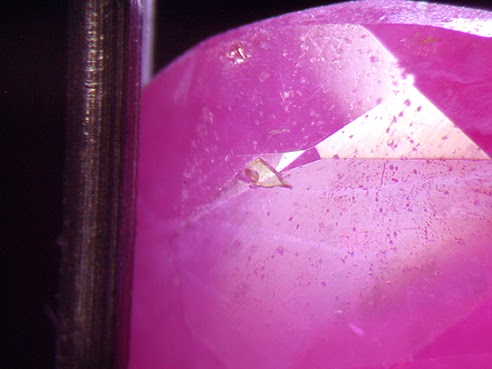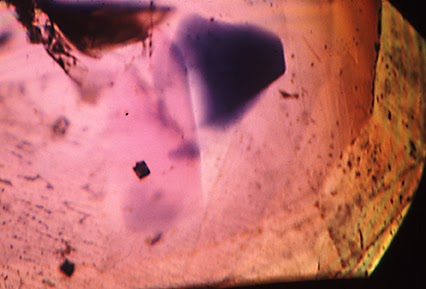Inclusions in Rubies
Importance of Understanding Ruby Inclusions
The inclusions in a ruby are equivalent to a fingerprint, from the type that are present, to their location, size, transparency, and relief (visibility) against the ruby’s body color. Additionally, certain inclusions give a trained gemologist a great deal of information from treatment to possibly the origin of the stone. These inclusions are what enable distinction between natural, treated, and synthetic gemstones.
Typical Ruby Inclusions
Cavities

As the name suggests, these are empty spaces that reach the surface of the stone. A common treatment for visible cavities is fracture-filling with colored glass. Extreme cavities can cause durability issues that glass cannot compensate for. In these cases the stone is heated with flux to restore durability and hopefully improve color.T
The yellow spots are flux filled cavities→

Color Zoning
Common in all corundum varieties, color zoning is a concentration of color in different parts of a stone. Sometimes cutters take advantage of color zoning to display color in parts of the stone that do not have any.
Note: color zoning in corundum can produce multicolored stones like parti-colored tourmalines, sometimes called parti-colored sapphires. If this were to happen to a ruby, it would only qualify as a ruby if red accounts for more than 50% of the color of the stone.

Twinning Planes – Also known as Lamellar Twinning
Twinning planes are not material that is physically included in the host crystal. They result from the ruby reacting to changes in its environment during formation. Since the temperature and pressure is not always stable throughout formation and cooling, the crystal changes the direction of its growth. This change is visible as twinning planes.
It is also possible to have numerous inclusions trapped in these planes.

Fingerprint Inclusions
Fingerprints are incredibly common in sapphires and rubies. This is because they are evidence of fractures occurring and healing in the stone naturally. Many stones cannot heal their fractures, like emeralds.
While this is a naturally occurring inclusion, synthetic rubies can show fingerprints too because this is a specific characteristic of the corundum mineral and not its inclusions.
Halo or Discoid Fractures

As the name implies, these inclusions form in a circular shape. This is a type of tension fracture between the ruby crystal and a liquid or solid inclusion due various factors. For example, a discoid fracture can occur because another crystal cools at a different rate than the host ruby crystal. This difference in cooling speed creates tension that naturally results in a discoid fracture.
These discoid fractures can also occur in heat-treated stones, though they have a different appearance and can be a tool to help gemologists identify heat-treated rubies.
Included Crystals

When forming in nature rubies often grow with other crystals like garnets, and a variety of other elements. This leads to foreign material (anything that is not a ruby) forming inside the ruby crystal. Other examples of included crystals are pyrite, zircon, calcite, and spinel to name a few.

Aside from forming needles in corundum, rutile can become red crystals too.
Left: This Kenyan ruby is home to several orangy-brown protogenetic crystals of rutile. Field of View: 1.45mm

Pinpoints and Clouds
Inclusions that are incredibly small at the microscopic level are called pinpoints. When there are a lot of pinpoints clustered together, the formation is called a cloud since these pinpoints do not qualify as a feather, fingerprint, or group of included crystals.
On the right there some rutile needles present along with inclusions with unusual appearance.

Liquid Inclusions
Liquid inclusions can take a myriad of appearances inside rubies like in fingerprints, cavities, discoid fractures, and even be sandwiched between twinning planes.
Very frequently liquid inclusions fill up negative inclusions, though this is not always an inclusion that can be confirmed easily.
Negative Crystals & Two-Phase Inclusions
We know what an included crystal is, so imagine if there was no crystal there and the space was empty instead. That is a negative crystal. Negative crystals form with the same crystal habit as the host material, making them a handy identifying tool for gemologists when correctly identified.
A two-phase inclusion is an inclusion with a liquid and a gas in the same cavity inside a ruby (can be almost any place there is a liquid inclusion).

While the image on the right is actually a flux-healed ruby, it can serve as an example of what a negative crystal and two-phase inclusion looks like. Gas bubbles can be flattened into weird forms, but are a dead giveaway to a negative crystal. Since a gas bubble in a natural ruby cannot be visible without a medium (liquid), we now know it is a two-phase inclusion.
As for what is actually going on in the photo and the evidence for it, the surface of the negative crystals is unclear and partially dissolved. The inclusions around it also share a similar fried and whitish appearance, all indicating heat treatment. Natural gas bubbles are also one of the first inclusions to go with any level of heating, which means the bubbles are a result of quickly cooled flux-filler.
Determining negative crystals without obvious identifiers can be incredibly difficult, especially without special gooseneck, fiber-optic lights with daylight equivalent light. The name is a mouthful, but lab gemologists swear by these lights.
Silk

Silk is the trade name for rutile needles in rubies and sapphires. They are a type of crystal formation, but a differentiation is made between these needles and crystals. These needles are thin and fine, forming in a regular pattern within the stone. They resemble something that is woven; hence the term “silk”.
The condition of silk is usually very telling of how intensely the ruby has been heated. Silk does not recrystallize until somewhere around 1,200 and 1,600 degrees celsius, and the appearance does change at the microscopic level before then. Silk can show rainbow colors of which fade with heat-treatment, and dissolve at higher temperatures. It often leaves behind some types of traces due to the high-melting point, and is easy to spot due to their specific orientation in corundum.
Assuming no major irregularities, silk forms in three directions. Two directions form at a 60 degree angle, like on a sheet of paper. The third direction forms perpendicular to the sheet of paper, meaning it goes down perfectly straight. Not to mention the way it forms varies between different mining sources, though be reminded that there are always exceptions.


Needles
Silk is a form of needles, but needles has a broader definition. A needle is actually a crystal inclusion in a ruby, however it is much longer and skinnier, hence the term needle. They can be formed out of all different types of crystals, though certain ones tend to be more common than others in corundum. Hollow tubes inside the gemstone can also qualify as needles too.

